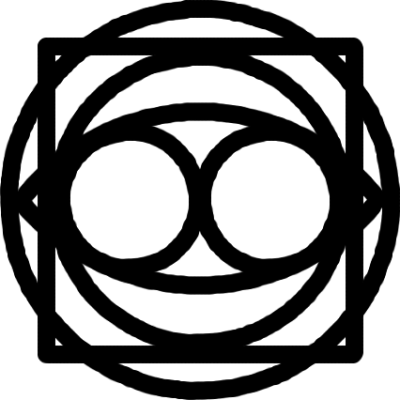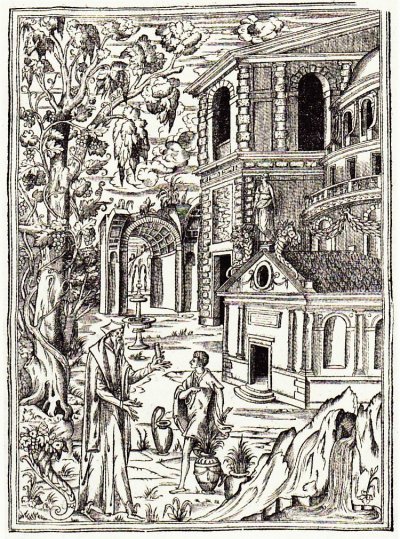This Intellectual Food
August 28th, 2007
Portions of two engravings from the first illustrated edition of Milton‘s Paradise Lost, 1688: the first by P. P. Bouche; the second by Michael Burghers.

Satan (the whispering toad) tempts Eve in a dream to pluck from the tree of knowledge and so taste (b5, l67-73):
— O fruit divine,
Sweet of thy self, but much more sweet thus cropped,
Forbidden here, it seems, as only fit
For Gods, yet able to make gods of men:
And why not gods of men, since good, the more
Communicated, more abundant grows,
The author not impaired, but honoured more?

Whereupon Adam consoles Eve (bv, l100-113):
— But know that in the soul
Are many lesser faculties that serve
Reason as chief; among these fancy next
Her office holds; of all external things,
Which the five watchful senses represent,
She forms imaginations, airy shapes,
Which reason joining or disjoining, frames
All what we affirm or what deny, and call
Our knowledge or opinion; then retires
Into her private cell when nature rests.
Oft in her absence mimic fancy wakes
To imitate her; but misjoining shapes,
Wild work produces oft, and most in dreams,
Ill matching words and deeds long past or late.
Squaring the Circle
August 21st, 2007
An exercise in contemplative geometry from Robert Lawlor’s Sacred Geometry, 1982.
“There are a number of diagrams in the literature of Sacred Geometry all related to the single idea known as ‘Squaring of the Circle’. This is a practice which seeks, with only the usual compass and straight-edge, to construct a square which is virtually equal in perimeter to the circumference of a given circle, or which is virtually equal in area to the area of a given circle. Because the circle is an incommensurable figure based on π, it is impossible to draw a square more than approximately equal to it. Nevertheless the Squaring of the Circle is of great importance to the geometer-cosmologist because for him the circle represents pure, unmanifest spirit-space, while the square represents the manifest and comprehensible world. When a near equality is drawn between the circle and the square, the infinite is able to express its dimensions or qualities through the finite” (p74).
Here I have drawn the former arrangement (perimeter equal to circumference):

The derivation begins with an initial circle (within the square) of radius unity. Along its horizontal diameter are drawn two tangent circles, each with radius one half. Observe that the total circumference of the smaller circles equals the circumference of the initial circle, but the total area of the smaller circles is one half that of the initial circle: “One has become Two” (p73), an image of the primary duality, of yin-yang.
Next are drawn two arcs from the ends of the initial circle’s vertical diameter with radius tangent to the far sides of the smaller circles. This radius is φ, the golden ratio, dividing the vertical radius of the initial circle into the golden section of lengths 1/φ and 1/φ2. The two arcs meet to create a vesica that encloses the primary duality — the mouth of Ra, the Word, the vibrating string.
Around the initial circle is drawn a tangent square, with side 2, perimeter 8; and, finally, a large circle is drawn with diameter equal to the width of the vesica, 2√φ, giving a circumference of 2π√φ = 7.993, approximately equal to 8. The circle is squared.
A Fugitive and Lurid Gleam
August 10th, 2007
A pen and ink drawing by Edward Gorey from The Iron Tonic, 1969.
Click image for larger version.
“A fugitive and lurid gleam | Obliquely gilds the gliding stream” (p11).
De l’Orme’s Architectural Allegories
August 5th, 2007
Two woodcuts from Philibert de l’Orme‘s The first volume of architecture (Le premier tome de l’architecture), 1567, as reproduced in Taschen’s Architectural Theory.

“The bad [architect] wanders bereft of hands and eyes through a barren landscape with a Medieval castle” (p131).

“By contrast, the good architect stands in a flourishing garden, has many hands, is surrounded by Classical and new buildings alike, and is familiarizing young people with his scientific discipline” (p131).
Cusanus’s Paradigmatic Diagram
August 1st, 2007
Nicholas of Cusa‘s paradigmatic diagram (figura paradigmatica, a.k.a. Diagram P) from his 1441/2 On Surmises (De Coniecturis), translated by Jasper Hopkins.
“Conceive of a pyramid-of-light as progressing into darkness and of a pyramid-of-darkness as progressing into light; and reduce to [that] figurative conception everything that can be investigated, so that by guidance from what is perceptible you can turn your surmise toward hidden [truths]. And in order that you may be aided by means of an example, consider the universe as reduced to the diagram here below. Notice that God, who is Oneness, is as the base-of-light; but the base-of-darkness is as nothing. Every creature, we surmise, lies between God and nothing” (p182).

The Latin labels are unitas: oneness; basis pyramis lucis: base of the pyramid of light; tertium caelum:third heaven; supremus mundus: uppermost world; secundum caelum: second heaven; medius mundus: middle world; primum caelum: first heaven; infimus mundus: lowest world; basis pyramis tenebrae: base of the pyramid of darkness; alteritas: otherness.
“The definition of ‘oneness’ is ‘indivisibility in and of itself and separation from all else.’ Hence, we say that oneness is called by the names of the many characteristics of its power. For whichever names indicate a certain indivisibility, distinctness, and union befit oneness. Now, the [foregoing] diagram includes, under [the label] ‘oneness,’ all such [befitting] things; and under [the label] ‘otherness’ it includes their opposites. Hence, for indivisibility to proceed into divisibility is nothing other than for oneness to descend into otherness” (p183-4).
“If you want to behold, intellectually, oneness in otherness, then pay very careful attention also to the following: viz., that for oneness to proceed into otherness is, at the same time, for otherness to return into oneness. For example, for the soul to be in the body is for the soul to proceed into the body in such a way that the body’s oneness enters into the soul. Likewise as regards form: the more one and the more perfect each form is, the more its proceeding [into otherness] is otherness’s returning [into its oneness]. For by means of a simple act of understanding, conceive of proceeding as conjoined with returning, if you want to arrive at those hidden truths which are more truly attained above reason (which separates progression from returning) by intellect alone (which folds opposites into a single bond)” (p187-8).
“You must notice that light’s descending is nothing other than darkness’s ascending. And God’s being in the world is nothing other than the world’s being in God. And for actuality to proceed into potentiality is nothing other than for potentiality to arrive at actuality. And a point’s ascending into corporeality is nothing other than corporeality’s descending into a point. And for darkness to elevate itself into light is nothing other than for light to descend into darkness. Likewise, for the potentiality of matter to proceed into the actuality-of-form is nothing other than for form’s actuality to descend into matter’s potentiality. Therefore, with intellectual acumen conjoin the ascent and the descent, in order that you may surmise more truly” (p217, c.f. Meister Eckhart’s words on coinherence and God’s eye).
“For the more subtly the mind contemplates itself in and through the world unfolded from itself, the more abundantly fruitful it is made within itself” (p165).
* * *
In edition Codex Latinus Cusanus 218 (1445), the diagram is situated horizontally rather than vertically, an arrangement seemingly familiar to Yeat’s instructors 500 years later (c.f. Yeat’s Concord and Discord with Cusanus’s oneness and otherness).

